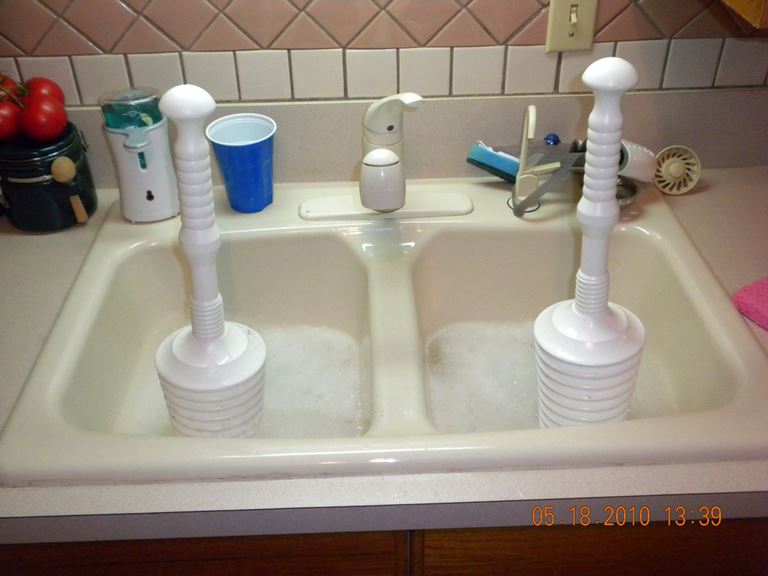
Kitchen sinks can become clogged from food residue building up over time, or from an accidental dump down the drain. Either way, the clog has to be dealt with before free flow can be restored. It is helpful if you know the location and composition of the clog exactly, but most methods will still work even if you do not.
You have three options for clearing your clogged sink. You can use a plunger, a drain auger, or no tools at all.
Perhaps the most common remedy for clogged drains is caustic liquid drain cleaner. Drain cleaner is effective if the clog is not too sizable and organic in material, Most importantly when using drain cleaner, you must be able to safely apply the chemical to the blockage. If the clog has formed out of the reach of Liquid Plumr or Drano, then their adding them to the mix will only make the situation worse.
A safer is alternative is hot water and dishwashing soap. This combination can lubricate and decompose many of the greasy or oily build ups encountered in clogged kitchen sink drains. Simply squirt some soap as far down the drain as you can. Next, pour, safely, hot water into the sink. The hotter the better, but tap water temperature will do in most cases. Let this combo set for at least an hour, then flush with more hot water, until flow is freely restored.
Most kitchen clogs will quickly succumb to a plunger. This is because typically kitchen sink clogs are blockages composed of smaller particles massed together, like rice or pasta. Plungers work by agitating the water surrounding the clog, quickly stirring up the blockage material and hopefully flushing it away down the drain.
Use a plunger designed for sinks; they will typically have a wider open face for covering the larger drain in kitchen sinks. Keep enough water in the drain and sink for the plunger to work with, and take several strong strokes of the plunger, not a quick forceful jab. Again, you want to break up the clog into smaller components, not wedge it further into place.
Do not use a snake on a drain with a garbage disposal! This won’t work, is dangerous, and can even ruin your disposal, your drain snake, or more likely, both. Only use your drain auger on sinks without garbage disposals.
Drain snaking a kitchen sink is easy. Follow your manufacturer’s instructions, extending the cable down the drain until your hear the gurgling of a busted clog. Rinse the drain and snake thoroughly with water as you reel it back in, to clear the blockage material away and to clean your drain snakes for storage.
That’s it! You should have another chore checked off. Good work!
 PermaFLOW Never-Clog DrainNever hassle with the tassle again.
PermaFLOW Never-Clog DrainNever hassle with the tassle again.
 Telescoping Magnetic Pick-Up ToolExtends up to 30 inches. Magnet pulls up to 15 lbs.
Telescoping Magnetic Pick-Up ToolExtends up to 30 inches. Magnet pulls up to 15 lbs.
 Blue Donuts Plunger in Bronze Powder CoatThis is the perfect plunger for any home. Stylish design fits elegantly and discreetly in any style bathroom. This was designed to be used at any angle and fit snugly in any drain.
Blue Donuts Plunger in Bronze Powder CoatThis is the perfect plunger for any home. Stylish design fits elegantly and discreetly in any style bathroom. This was designed to be used at any angle and fit snugly in any drain.
Step-by-step instructions for making quick work of clogged or slowly flowing bathroom sink drains
UncloggingDrains101.comWhen clogs form in bathroom sinks, showers, bathtubs, kitchen & utility sinks, or shop & laundry drains—then the preferred tool will be a drain auger.
UncloggingDrains101.comLearn various easy methods for fixing a blocked commode when there isn't a plunger or closet auger available
UncloggingDrains101.comSolve your clogged toilet problem today--Learn to unblock a toilet using a plunger, using a toilet snake, or using whatever is handy!
UncloggingDrains101.com Black & Decker The Complete Guide to PlumbingYou might not have to call a plumber; get the most comprehensive, up-to-date book on home plumbing for DIYers of all skill levels instead
Black & Decker The Complete Guide to PlumbingYou might not have to call a plumber; get the most comprehensive, up-to-date book on home plumbing for DIYers of all skill levels instead
 Turbo Snake Drain Hair Removal ToolClear clogged bathroom sinks with ease using this tool seen on TV
Turbo Snake Drain Hair Removal ToolClear clogged bathroom sinks with ease using this tool seen on TV
Everything about unclogging floor drains, from the toughest job to the quickest maintenance
UncloggingDrains101.comLearn how to use the common drain snake and be prepared to do-it-yourself when it comes to slow or stopped drains in the home
UncloggingDrains101.comSolve your clogged toilet problem today--Learn to unblock a toilet using a plunger, using a toilet snake, or using whatever is handy!
UncloggingDrains101.com